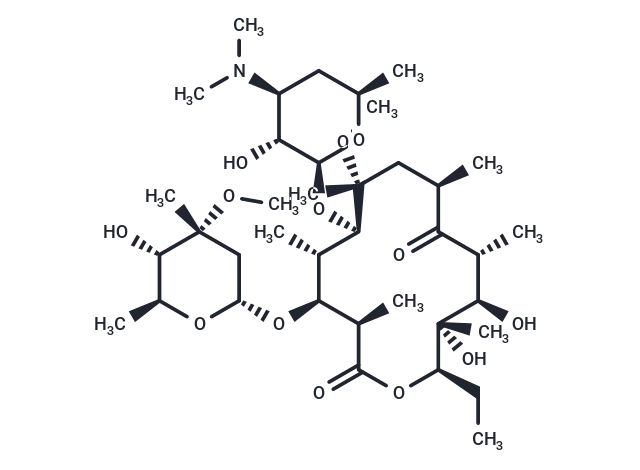Shopping Cart
Remove All Your shopping cart is currently empty
Your shopping cart is currently empty
Clarithromycin (A-56268) is a Macrolide Antimicrobial. The mechanism of action of clarithromycin is as a Cytochrome P450 3A4 Inhibitor, and Cytochrome P450 3A Inhibitor, and P-Glycoprotein Inhibitor. The chemical classification of clarithromycin is Macrolides.

| Pack Size | Price | USA Warehouse | Global Warehouse | Quantity |
|---|---|---|---|---|
| 100 mg | $50 | In Stock | In Stock | |
| 200 mg | $57 | In Stock | In Stock | |
| 500 mg | $74 | In Stock | In Stock | |
| 1 mL x 10 mM (in DMSO) | $54 | In Stock | In Stock |
| Description | Clarithromycin (A-56268) is a Macrolide Antimicrobial. The mechanism of action of clarithromycin is as a Cytochrome P450 3A4 Inhibitor, and Cytochrome P450 3A Inhibitor, and P-Glycoprotein Inhibitor. The chemical classification of clarithromycin is Macrolides. |
| In vitro | Clarithromycin suppresses this production in a dose-dependent manner in both monocytes and THP-1 cells. Clarithromycin regulates three other promoters that have either the NF-kappa B or the AP-1 binding sequences: two synthetic (pAP-1-Luc and pNF-kappa B-Luc) and one naturally occurring (ELAM-Luc). [1] Clarithromycin suppresses NF-kappaB activation induced by TNF-alpha in U-937 and Jurkat cells in a concentration-related manner. Clarithromycin inhibits NF-kappaB activation induced by TNF-alpha in U-937, Jurkat, and A549 cells and PBMC and by SEA in PBMC. Clarithromycin prevents NF-kappaB-dependent reporter gene expression in U-937 cells. [2] Clarithromycin results in a significant suppression of production of each cytokine in 71% and a significant increase in 29% of the human monocytes. [3] Clarithromycin inhibits tumor necrosis factor (TNF)-alpha-induced IL-8 gene expression in a dose- and incubation time-dependent manner. Clarithromycin represses AP-1 binding in TNF-alpha-treated BET-1A cells. Clarithromycin represses IL-8 gene transcription mainly via the AP-1 binding site in human bronchial epithelial cells. [4] Clarithromycin suppresses IL-1 beta gene expression in human nasal epithelial cells stimulated by H. influenzae endotoxin (HIE). Clarithromycin suppresses intercellular adhesion molecule-1 gene expression in nasal fibroblasts stimulated by IL-1 beta. Clarithromycin reduces DNA-binding activity of NF-kappa B in both human nasal epithelial cells and fibroblasts stimulated by HIE or IL-1 beta, respectively. [5] |
| Synonyms | A-56268 |
| Molecular Weight | 747.95 |
| Formula | C38H69NO13 |
| Cas No. | 81103-11-9 |
| Smiles | O([C@H]1[C@@](OC)(C)C[C@@H](C)C(=O)[C@H](C)[C@@H](O)[C@](C)(O)[C@@H](CC)OC(=O)[C@H](C)[C@@H](O[C@H]2C[C@](OC)(C)[C@@H](O)[C@H](C)O2)[C@@H]1C)[C@H]3[C@H](O)[C@@H](N(C)C)C[C@@H](C)O3 |
| Relative Density. | 1.18 g/cm3 |
| Color | White |
| Appearance | Solid |
| Storage | Powder: -20°C for 3 years | In solvent: -80°C for 1 year | Shipping with blue ice/Shipping at ambient temperature. | ||||||||||||||||||||||||||||||
| Solubility Information | DMSO: 38 mg/mL (50.81 mM), Sonication is recommended. | ||||||||||||||||||||||||||||||
| In Vivo Formulation | 10% DMSO+90% Corn Oil: 2 mg/mL (2.67 mM), Sonication is recommeded. Please add the solvents sequentially, clarifying the solution as much as possible before adding the next one. Dissolve by heating and/or sonication if necessary. Working solution is recommended to be prepared and used immediately. The formulation provided above is for reference purposes only. In vivo formulations may vary and should be modified based on specific experimental conditions. | ||||||||||||||||||||||||||||||
Solution Preparation Table | |||||||||||||||||||||||||||||||
DMSO
| |||||||||||||||||||||||||||||||
| Size | Quantity | Unit Price | Amount | Operation |
|---|

Copyright © 2015-2025 TargetMol Chemicals Inc. All Rights Reserved.